Pre-Raphaelites to Aesthetes: Their Influence on Aesthetic Dress
by Judith Hollenberger Dunlap, First published for the March/April 2012 issue of Finery
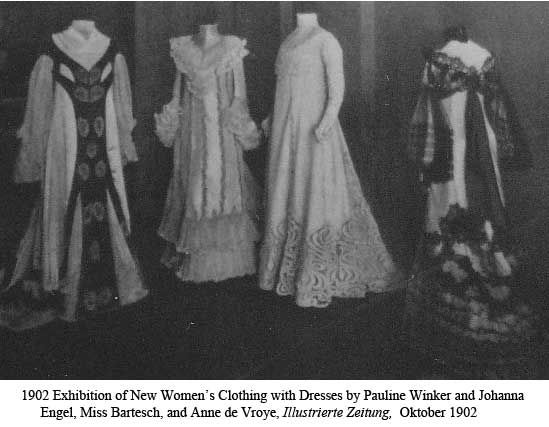
The Artistic Dress movement in the late 19th century was born of two earlier artistic reform movements. In 1848 the Pre-Raphaelite Brotherhood was founded in Great Britain by William Holman Hunt, John Everett Millais, and Dante Gabriel Rossetti. This Brotherhood of painters, poets, and literary critics believed that artists should return to the intense colors, complex composition, and classical themes exemplified by art before Raphael. Hence the name, Pre-Raphaelite. They took inspiration from the natural world and strived to depict nature as realistically as possible within medieval style compositions. William Morris and Edward Burne-Jones soon joined the Pre-Raphaelites. The British Royal Academy and many critics derided Pre-Raphaelite works as backwards and ugly.
One of the major proponents of the Pre-Raphaelites was the British critic John Ruskin. He argued that poetry and painting are associated, and that painters, like writers, could be prophets. He argued that painters could convey “though the medium of allegory and symbolism profound insight into the nature of God.” The Pre-Raphaelites believed that art should convey an emotional or spiritual message to uplift and affect the viewer.
In the late 1860’s a new art movement, the Aesthetic Movement, emerged. Unlike the symbol-laden morality of the Pre-Raphaelites, the Aesthetes believed that art should be created ‘for art’s sake’ and express ideas unencumbered by morality. The Aesthetes believed that beauty was an end in itself. Art should provide sensuous pleasure, without having to convey a moral or sentimental message.
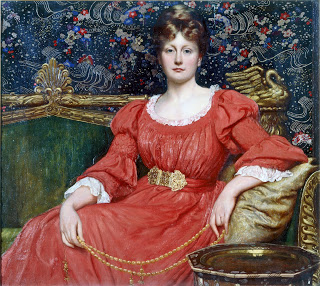
Aestheticism drew on eclectic sources, had a strong Japanese influence due to the opening of Japan for trade in 1868, and promoted the idea that painting was analogous to music as both are abstract in nature. The Aesthetic movement, labeled as Art Nouveau in France, found its way to Britain in 1877 and there became known as ‘Arts and Crafts’. The first art exhibition of the Arts and Crafts Movement was in London in 1888. In the United States the movement was labeled ‘Craftsman.’
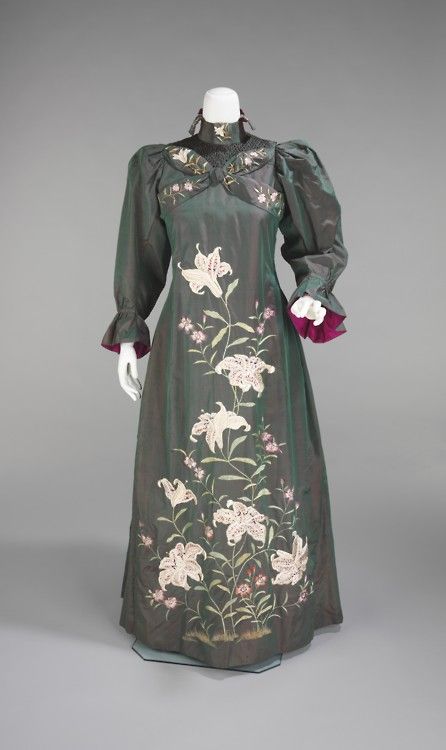
The Pre-Raphaelite and the later Aesthetic Movement artists had their models dress in costumes inspired by classical Greek, Medieval, and Renaissance clothing. The women in their lives also dressed this way. The Artistic Dress Movement became associated with artists and intellectuals. The Aesthetes rejected contemporary dress. They found its unnatural colors, man-made materials, and exaggerated silhouettes offensive.
In Britain and the United States, the Artistic Dress style was influenced by the new political ideas of Fabian socialism and first wave feminism as well as the health-oriented dress reform movement. Fabian socialism promotes moving towards socialist values gradually rather than revolutionary and provided some of the foundations for the current British Labor Party.

The Royal School of Art Needlework was founded in Britain in 1872 to promote “ornamental needlework for secular purposes” and to provide employment for “poor gentlewomen.” Throughout the 1870’s William Morris and Edward Burne-Jones designed secular embroidery for hangings, cushion covers, and fine screens. The designs were made up by women in Morris’ company and sold as designs for home enthusiasts.
In the 1880’s William Morris championed the revival of tapestry weaving. His enthusiasm was shared by Edward Burne-Jones and they created many designs for tapestries. The emphasis on needlework reflected a reaction against Industrialism and mechanized production and a return to individually hand-crafted items. It also reflected the Arts and Crafts ideal that every object in a person’s home should be useful or beautiful, preferably both.
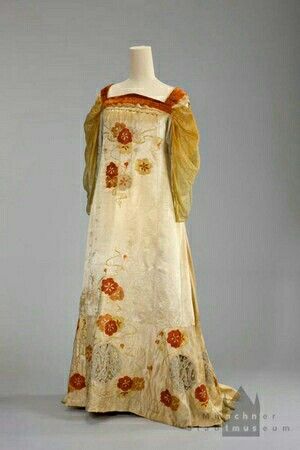
By 1880 it was common enough for women of fashion and the stage to wear Artistic Dress that cartoonists began lampooning it. Gilbert and Sullivan wrote a satire of the artistic cult called “Patience.” Gilbert designed the dresses for the operetta, which were made from Liberty & Co. silks. Liberty & Co. continues to carry some of the fabric designs from the Artistic Dress Movement today. The British writer Oscar Wilde toured the United States in 1881-82 to promote “Patience” and to foster the Artistic Dress Movement. Artistic Dress teas, soirees, plays, and musicals were held, primarily in the larger cities to encourage the spread of the new dress concepts.
In 1884 the International Health Exhibition was held in Britain. This exhibition featured clothing reforms that rejected tight lacing corsets. Corsets were accused of displacing internal organs, affecting breathing, and causing muscles to weaken. Although there is controversy around the evidence of corsets actually displacing internal organs, the movement for dress reform was vocal about the horrors of tight lacing. New pastimes for women and men such as tennis and bicycling were also influencing clothing designs that allowed more freedom of movement.
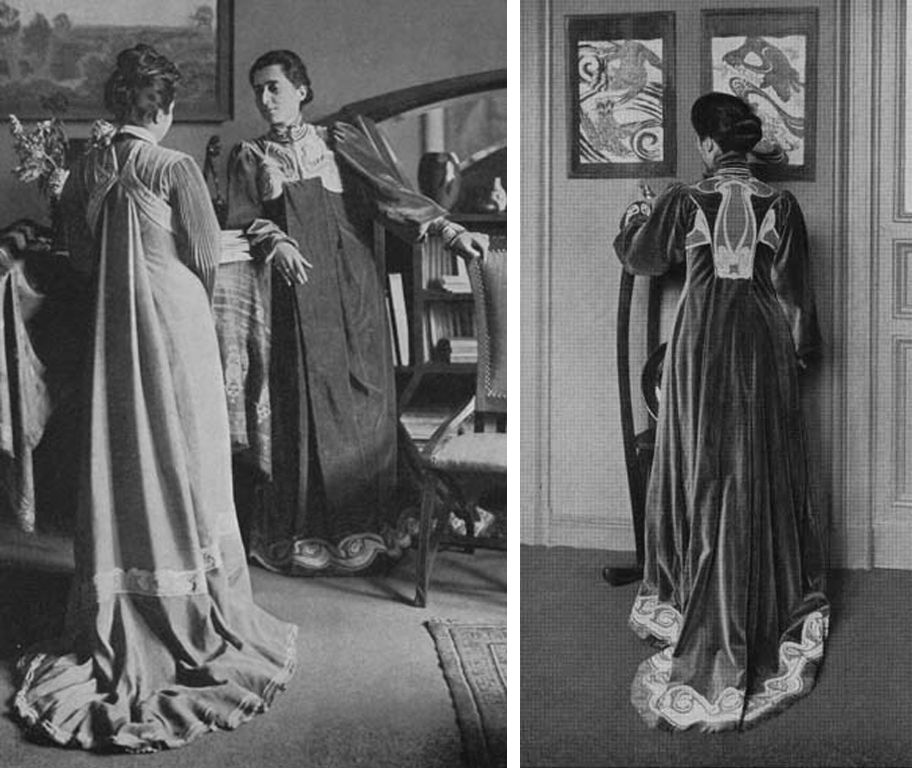
The mid 1880’s organized effort for rational dress inspired the formation of the ‘Healthy and Artistic Dress Union’ in Britain, which included Arthur Lasenby Liberty, the founder of Liberty of London (aka Liberty and Co.) In 1884 E.W. Godwin joined Liberty and Co. and began creating designs for a newly opened department of artistic and historic dress, the “Artistic and Historic Costume Studio.”
Along with William Morris and Edward Burne-Jones, another Arts and Crafts movement artist that heavily influenced fashion was Kate Greenaway. Her drawings and watercolors often featured children in a mix of Georgian and Regency inspired ‘quaint’ clothing that was simple in design and loose and flowing.
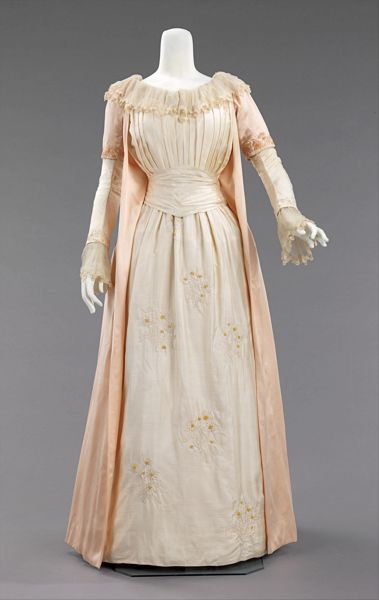
Artistic Dress for women usually means tea gowns or wrappers. They were generally worn at home, when entertaining close friends, or on country weekends. They were considered to be comfortable, romantic, and a little bit daring as they were worn without a corset. Artistic Dress typically features naturally dyed fabric, often made on hand looms, with hand-worked details such as smocking and embroidery. There are pictures of William Morris’ wife Jane and their two daughters in simple dresses with no trimming other than embroidery at the neckline. The bodices of the dresses are gathered but not fitted and the women are not wearing corsets.
Many of the tea gowns in the 1880’s, even when not specifically Artistic Dress, featured Artistic Dress elements such as trains, Watteau style back pleats, and elongated sleeves. Artistic Dress for men replaced heavy starched collars or cravats with soft collars and bows. The more fashion-conscious Aesthete Oscar Wilde adopted a style of velvet suit with knee breeches, similar to what boys wear in Kate Greenaway’s art.
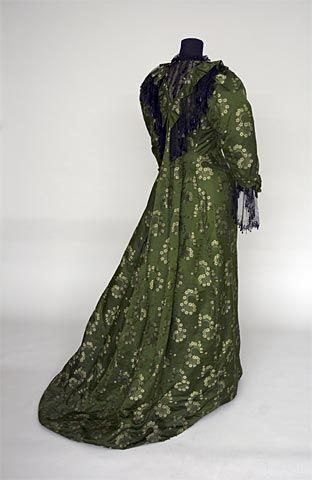
There are patterns available for Artistic Dress outfits. La Mode Bagatelle has an ‘Artistic Reform Tea Gowns’ pattern, available from Ravenrook Ltd. Truly Victorian has an 1882 Tea Gown pattern. It’s made to be worn with a corset but could be adapted. Also, look to the major pattern companies’ Medieval and Renaissance costume patterns. As the Pre-Raphaelite and Aesthetic Movement artists drew their inspiration from that time period, you can, too! For men, look to images of Oscar Wilde, who wore a velvet smoking jacket and matching knee breeches.

Artistic Dress never became widely adopted in Britain, France, or the United States, but its ideals impacted the evolution of everyday dress forever.
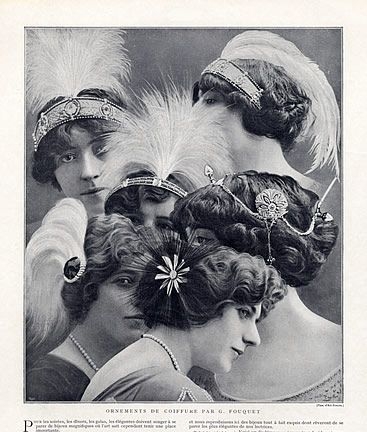
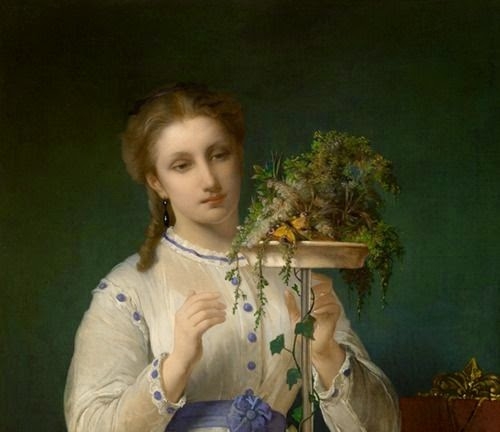
Leave a comment